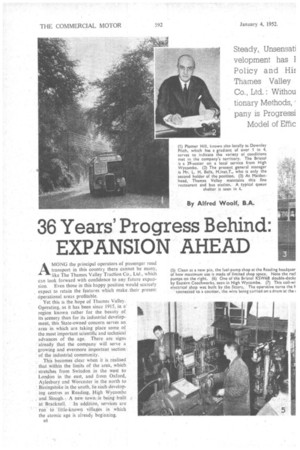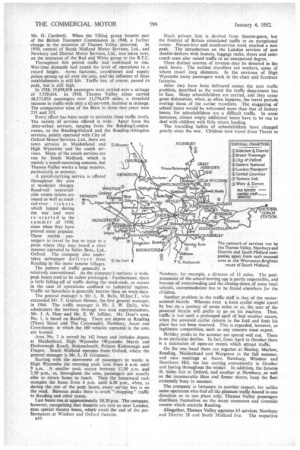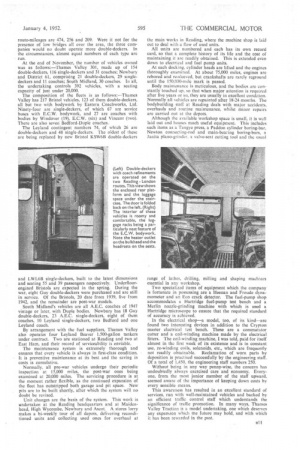36 Years' Progress Behind: EXPANSION AHEAD
Page 42

Page 43

Page 44

Page 45

If you've noticed an error in this article please click here to report it so we can fix it.
Steady,. Unsensat] velopment has Policy and Hif. Thames Valley Co., Ltd, Withou tionary Methods, pany is Pro gressi Model of Effic
By Alfred Woolf, B.A.
AMONG the principal operators of passenger road transport in this country there cannot be many, like The Thames Valley Traction Co.. Ltd., which can look forward with confidence to any future expan
sion. Even those in this happy position would scarcely expect to retain the features which make their present Operational areas profitable.
Yet this is the hope of Thames Valley. Operating, as it has been since 1915, in a' region known rather for the beauty of• its scenery than for its industrial development, this State-owned concern serves an area in which are taking place some of the.most important scientific and technical advances of the age. .There are, signs already that the company will serve a growing and evermore important section. of the industrial community.
This becomes clear when it is realised that within the limits of the area, which stretches from Swindon in the west to London in the east, and from Oxford, Aylesbury and Worcester in .the north to Basingstoke in the south, lie such developing centres as Reading, High Wycombe and Slough.-,• A new town :is' being built :! at Bracknell. ' In -addition, services are run. to "little-known villages in which the atomic age is already beginning.
ri8 Operations commenced in July, 1915, when the British Automobile Traction Co., Ltd., started a group oi Thames valley services running between Maidenhead, Reading and Streatley. To begin with the fleet consisted of four Leyland single-deckers_ Additional routes were soon started, including Reading-Mortimer, Wokingham, Maidenhead and Windsor. When the present engineer, Mr. B. E. Sutton, M.I.Mech.E., joined the company in April, 1920, another six vehicles had been obtained, including some Belsize 32-seat single-deckers, with bodywork by Brush Coachwork and Birch.
Driver Hampton, who drove the first. bus on the first service, is still in the company's .employment, a record
• of service equalled by other members of the staff. It was on July 10, 1920, that The Thames Valley Traction Co., Ltd., was constituted to take over the B.A.T. services. Ten new Thornycroft 7-type chassis had been obtained and later additional ex-W.D. vehicles of the same make were purchased, During the next two or three years, these were converted to forward control— an innovation of which the company remains juStillably proud—and fitted with double-deck bodies. EVentually all were equipped with pneumatic tyres.
Two years later, the headquarters, originally established in Reading and later transferred to Maidenhead, -moved finally to Reading, This has been the centre of the Thames Valley company ever •since.
Meanwhile, in 1924, a further ektension in the range of operations had occurred when the Cambrian Coaching Co., and a number of other ThornYcroft vehicles owned by London operators and run under such names as IThique. Shamrock, Admiral and Pioneer, were taken over. From 1922-1928 the company also operated the Ukbridgc garage of the 'London General Omnibus Co., Ltd., with Thornycroft vehicles, A ReadingLondon route had been started in 1926 with TillingStevens single-deckers. The acquisition of the additional Thornycroft vehicles marked a great stride forward.
Early in 1928. the first batch of 12 Leyland Titan TD1 double-deckers was delivered. As with all subsequent double-deckers, these were low-bridge types, . seating, first, 48 and later 51 passengers_ Among the vehicles delivered was the orginal TD1 prototype and the Titans completely altered the nature of the company's operations, as they did the whole field of public transport in Great Britain It is no.reflectiori on Thames Valley to mention that many of the 'T1211 Titans are still running, with the original bodywork, although petrol engines have long since been replaced by oil engines.
Some of the Ti`cans covered miles before being withdrawn from service, still with the original bodywork.
Railway Services Taken Over Bus services run in the area by the Great Western Railway, at Newbury and Twyford, for example, as well as elsewhere, were taken over in 1929, In 1931, the G.W. and Southern Railways became shareholders. A number of smaller operators was acquired. including Reliance Buses and Blue Star Coaches. • In 1929, too. Marlow and District Motor Services, Ltd., came under Thames Valley .control. In 1936, Ledbury Transport, Ltd., was taken over, in which year part of the activities of the Penn Bus Co., Ltd., was acquired, the other section passing into the hands of the London Passenger Transport Board. • The year before, Thames Valley was transferred from the B.A.T. to the Tilling group. Mr. Sidney Garcke, the founder and first chairman was succeeded by Mr. G. Cardwell. When the Tilling group became part of the British Transport Commission in 1948, a further change in the structure of Thames Valley occurred. In 1950, control of South Midland Motor Services, Ltd., and Newbury and District Motor Services, Ltd., was taken over, on the secession of the Red and White group to the B.T.C.
Throughout this period traffic had continued to rise. War-time demands had raised the level of operations to a record height. Arms factories, aerodromes and supply points sprang up all over the area, and the influence of these establishments is still felt. Traffic has, of course, passed its peak, but is still high, In 1938, 19,898,858 passengers were carried over a mileage of 7,739,454. In 1950, Thames Valley alone carried 48,571,874 passengers over 11,776,479 miles, a threefold increase in traffic with only a 62-per-cent. increase in mileage. The comparative sizes of the fleets in those two years were 213 and 313.
Every effort has been made to maintain these traffic levels. The variety of services offered is wide. Apart from the inter-urban services, ranging from the Reading-London routes, to the Reading-Oxford and the Reading-Abingdon services, jointly operated with City of Oxford Motor Services, Ltd., there are town services in Maidenhead and High Wycombe and the coach services. Many of the coach services are run by South Midland, which is mainly a coach-operating concern, but Thames Valley works a large number,
particularly in summer. ABINGDON A parcel-carrying service is offered throughout the area at moderate charges.
Road-rail n teravai Iable return tickets are issued as well as road
rail-river ticket s, which lapsed during the war and were re-started in the summer of 1950, since when they have proved most popular. These enable passengers to travel by bus or train to a point where they may board a river steamer operated by Salter Bros., Ltd„ Oxford. The company also undertakes newspaper delivery from Reading to the more remote villages.
The pattern of traffic generally is relatively conventional. As the company's territory is wide. peak hours tend to be rather prolonged. Furthermore, there is little falling-off of traffic during the week-ends, as occurs in the case of operations confined to industrial regions. Traffic on Saturdays is generally heavier than on week-days.
The general manager is Mr. L. H. Balls, M.Inst.T., who succeeded Mr. T. Graham Homer, the first general manager, in 1944. The traffic manager is Mr. J. W. Daily, who administers the territory through two area superintendents, Mr. J. A. Dear and Mr. E. W. Jeffries. Mr. Dear's area, No. 1, is based on Reading. There are depots at Reading (Thorn Street and The Colonnade), Newbury, Ascot and Crowthorne. in which the 180 vehicles operated in the area are housed.
Area No 2 is served by 142 buses and includes depots at Maidenhead, High Wycombe (Wycombe Marsh and Desborough Road), Stokenchurch. Princes Risborough and Fingest. South Midland operates from Oxford, v6here the general manager is Mr. L. H. Grimmett.
Starting with the movement of passengers to works in High Wycombe the morning peak lasts from 6 a.m. until 9 a.m. A smaller peak occurs between 1230 p.m. and 2.30 p.m., as, throughout the area, passengers are usually able to return home to lunch. Then the homeward rush occupies the buses from 4 p.m. until 6.30 p.m., when, as during the rest of the peak hours, every service bus is on the road. Between peaks there is much "shopping" traffic to Reading and other towns.
Last buses run at approximately 10.30 p.m. The company, however, recogniziog that theatres are rare so near London, runs special theatre buses, which await the end of the performances at Windsor and Oxford theatres.
ro roirester
110ANTAG0 Childnts
SWINDON Rufg
HUNGER
the Coast inkrenst Ea glcdunswell;Hill Hicjttclere ( iKinssclent 5ram12,7 BASINGSTOKE
Much private hire is derived from theatre-goers, but the Festival of Britain stimulated traffic to an exceptional extent. Private-hire and coach-service work reached a new peak. The introduction on the London services of new double-deckers with heaters, luggage racks, doors and semicoach seats also raised traffic to an unexpected degree.
Three distinct sources of revenue may be detected in the peak hours. The earliest, travellers are workers, some of whom travel long distances. In the environs of High Wycombe many passengers work in the chair and furniture factories.
After they have been delivered comes the next traffic problem, described as the worst the traffic department has to face. Many schoolchildren are carried, and they cause great dislocation, when, as often happens, the travel periods overlap those of the earlier travellers. The staggering of school hours would be welcomed more than that of factory hours, for schoolchildren are a difficult traffic. In some instances, almost empty additional buses have to be run to deal with children with little return loading.
The travelling habits of schoolchildren have changed greatly since the war. Children now travel from Theale to
`Th Portsmouth route of South Midland. Newbury, for example, a distance of 12 miles. The postponement of the school-leaving age is partly responsible, and because of overcrowding and the closing-down of some local schools, accommodation has to be found elsewhere for the children.
Another problem to the traffic staff is that of the motorassisted bicycle. Whereas even a keen cyclist might travel by bus on a journey of seven miles or so, the user of the powered bicycle will prefer to go on his machine. Thus, traffic is lost until a prolonged spell of bad weather occurs, when the powered cyclist returns to the fold and finds his place has not been reserved. This is regarded, however, as legitimate competition, such as any concern must expect.
Holiday peaks in the summer are spread well out. There is no particular decline. In fact, from April to October there is a succession of open-air events which attract traffic.
On the one hand there are regattas at Henley, Marlow, Reading, Maidenhead and Wargrave in the full summer, and race meetings at Ascot, Newbury, Windsor and Hawthorn Hill, the last starting conveniently in October and lasting throughout the winter. In addition, the famous St. Giles fair at Oxford, and another at Newbury, as well as the innumerable fetes and flower shows, keep the fleet extremely busy in summer.
The company is fortunate in another respect, for unlike some operators who find all the pleasure traffic bound in one direction or to one place only, Thames Valley passengers distribute themselves on the many commons and riverside resorts which encircle Reading.
Altogether, Thames Valley operates 63 services, Newbury and District 28 and South Midland five. The respective route-mileages are 474, 256 and 209. Were it not for the presence of low bridges all over the area, the three companies would no doubt operate more double-deckers. In the circumstances, almost equal numbers of each type are run.
At the end of November, the number of vehicles owned was as follows:—Thames Valley 301, made up of 154 double-deckers, 116 single-deckers and 31 coaches; Newbury and District 61, comprising 21 double-deckers, 29 singledeckers and 11 coaches; South Midland, 30 coaches. In all, the undertaking controls 392 vehicles, with a seating capacity of just under 20,000.
The composition of the fleets is as follows:—Thames Valley has 217 Bristol vehicles, 123 of them double-deckers, all but two with bodywork by Eastern Coachworks, Ltd. Ninety-four are single-deckers, of which 67 are service buses with E.C.W. bodywork, and 27 are coaches with bodies by Windover (19), E.C.W. (six) and Vincent (two). There are also severf Bedford-Duple coaches.
The Leyland contingent numbers 74, of which 26 are double-deckers and 48 single-deckers. The oldest of these are being replaced by new Bristol KSW6B double-deckers and LWL6B single-deckers, built to the latest dimensions and seating 55 and 39 passengers respectively. Underfloorengined Bristols are expected in the spring. During the war, eight Guy double-deckers were purchased and are still in service. Of the Bristols, 20 date from 1939, five from 1942, and the remainder are post-war models.
South Midland's vehicles are all A.E.C. coaches of 1947 vintage or later, with Duple bodies. Newbury has 18 Guy double-deckers, 23 A.E.C. single-deckers, eight of them coaches, 10 Leyland single-deckers, two Bedford and one Leyland coach.
By arrangement with the fuel suppliers, Thames Valley also operates four Leyland Beaver 1,500-gallon tankers under contract. Two are stationed at Reading and two at East Ham, and their record of serviceability is enviable.
The maintenance system is extremely thorough and ensures that every vehicle is always in first-class condition. It is preventive maintenance at its best and the saving in costs is cumulative.
Normally, all pre-war vehicles undergo their periodic inspection at 15,000 miles, the post-war ones being examined at 20,000 miles. The servicing procedure is at the moment rather flexible, as the continued expansion of the fleet has outstripped both garage and pit space. New pits are to be built shortly, after which the system will no doubt be revised.
Unit changes are the basis of the system. This work is undertaken at the Reading headquarters and at Maidenhead, High Wycombe, Newbury and Ascot. A stores lorry makes a bi-weekly tour of all depots, delivering reconditioned units and collecting used ones for overhaul at the main works in Reading, where the machine shop is laid out to deal with a flow of used units.
All units are numbered and each has its own record card, so that a complete history of its life and the cost of maintaining it are readily obtained. This is extended even down to electrical and fuel pump units.
At each docking, cylinder heads are lifted and the engines thoroughly examined. At about 75,000 miles, engines arc rebored and re-sleeved, but crankshafts are rarely reground until the 150,000-mile mark is passed.
Body maintenance is meticulous, and the bodies are constantly touched up, so that when major attention is required after five years or so, they are usually in excellent condition. Normally all vehicles are repainted after 18-24 months. The bodybuilding staff at Reading deals with major accidents. overhauls and routine maintenance, whilst minor repairs are carried out at the depots.
Although the available workshop space is small, it is well laid out and houses much useful equipment. This includes such items as a Tangye press, a Paddon cylinder boring-bar, Newton connecting-rod and main-bearing boring-bars, a Janita plane-grinder. a Valve-seat cutting tool and the usual range of lathes, drilling, milling and shaping machines essential in any workshop.
Two specialized items of equipment which the company is fortunate in possessing are a Heenan and Froude dynamometer and an Euo crack detector. The fuel-pump shop accommodates a Hartridge fuer-pump test bench and a Merlin nozzle-grinding machine with which is used a Hartridge microscope to ensure that the required standard of accuracy is achieved.
In the electrical shop—a model, too, of its kind--are found two interesting devices in addition to the Crypton master electrical test bench. These are a commutator cutter and a coil-winding machine made by the electrical fitters. The coil-winding machine, I was told, paid for itself almost in the first week of its existence and is in constant use, re-winding coils, solenoids, etc., which are frequently not readily obtainable. Reclamation of worn parts by deposition is practised successfully by the engineering staff. Of a total of 1,450, the engineering staff numbers 250.
Without being in any way penny-wise, the concern has undoubtedly always exercised care and economy. Everyone, from the most junior member of the staff upward, seemed aware of the importance of keeping down costs by every sensible means.
This awareness has resulted in an excellent standard of services, run with well-maintained vehicles and backed by an efficient traffic control staff which understands the significance of traffic promotion. In many ways, Thames Valley Traction is a model undertaking, one which deserves any expansion which the future may hold, and with which
• it has been rewarded in the past.




















































































